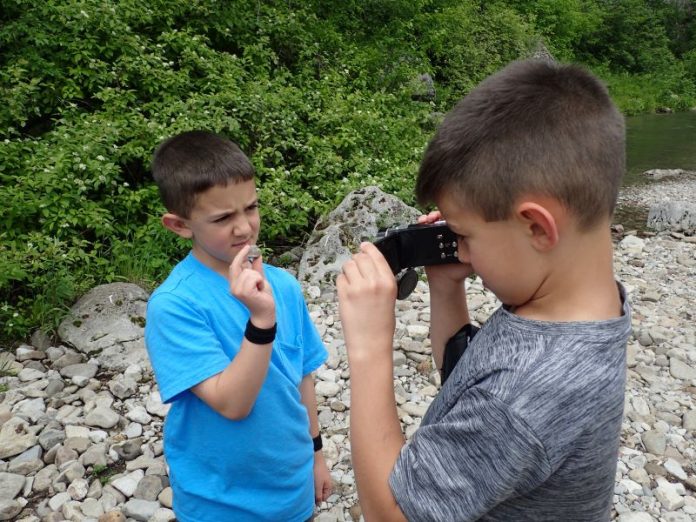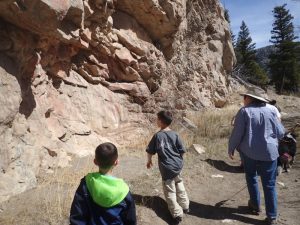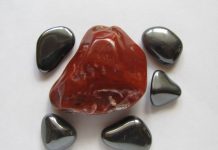
Rock collecting often starts when we’re in a gift shop. Those bags that you can fill with shiny, tumbled rocks are irresistible! If you want to take your collecting to the next level and move from the mall to the field, you’ve got to have the right gear.
Be Prepared!
Anytime we’re outside, particularly when working with rocks, we need to be prepared for rockhounding AND the weather. Check your weather app or go old school and watch the news before you go. Then make sure to pack for the forecast.
From head to toe, wear the best clothing for an outing of rock collecting and think of layers in case the weather changes during the day. Consider grabbing an extra fleece top or jacket. Small emergency parkas easily fit in a backpack and have prevented many rockhounds from becoming soaking wet in a sudden shower.

Courtesy Amy Grisak
Protect Yourself
Sun and bugs don’t have to ruin your day. Bug spray, a long-sleeved shirt, sunscreen and a hat are must-haves that no one regrets bringing along.
Protect your feet by knowing where you’re going and wearing the right shoes – water shoes for the creek and heavier boots for rocky climbs. Because rockhounding can be dirty and rough with the potential for skinned knees, you may want to wear jeans or heavier fabric long pants.
Eyewear is an absolute must. Do not let a sharp shard ruin the day!
Gloves are also an important must-have. They’re great when gathering larger rocks or using digging tools plus they add some protection from unexpected wildlife when you’re sifting through rocks and overturning habitats.

Courtesy Martina Morris
Rock Collecting Tools of the Trade
In many areas, rock collecting is as easy as picking up eye-catching specimens like agate, quartz and jasper from the stream bed, but at other times, it requires a bit more digging to find those special stones. Depending on where you’re going and what you hope to find, there are certain tools that can make the effort more successful.
It’s handy to pack along a small shovel to scoop up material or pry a larger rock out of the way. Once you’ve got a shovel or handful, a rock screen makes easy work sifting through to see if anything stands out.
A rock pick with a pointed end on one side and a chiseled end on the other is a useful option when a shovel is too much for the task and you just need to pry out certain rocks. It can also loosen the dirt before you scoop it out with a shovel.

Courtesy Amy Grisak
It’s Hammer Time
Sometimes knowing what you’ve got means splitting it in half. Think geodes! (Before you strike, always have your eye protection in place.)
For this task, it’s best not to use a regular hammer – they aren’t made for rock and the metal can chip and break. A rock hammer, sometimes called a geologist’s hammer, because it has a hammer-type head at one side with a chisel on the opposite end is what you need. Rock hammers are made of special steel that won’t break and are perfect for chipping off pieces of larger rocks or cracking smaller ones.
If you need something beefier, there’s also one called a crack hammer. This looks like a short-handled sledgehammer but with a smaller head. It’s also made of tempered steel, so it won’t break. It does a bang-up job of cracking larger stones. It can also be used with a rock chisel.
A rock chisel is a valuable tool for a more precise method of splitting a rock by placing the edge of the chisel where you want to break it and striking it with a hammer. This is definitely a project that is best done with an adult lending a hand because striking the chisel with the hammer, especially a bigger one, is a quick way to get hurt.
Rock Collecting: Taking a Closer Look
Once you’ve got your desired rocks, it’s time to take a closer look. If there’s a lot of soil still on the rocks, use a wire brush to take off the excess and rinse them with water if possible.
The best way to examine stones in the field is by using a 10X magnifying eyepiece. These are the small metal ones that fold in on themselves so they don’t break and are easy to carry. You can even put a string on it and wear it around your neck to keep it ready. A regular magnifying glass will also do the trick. Take a look to see if you can spot any fossils or unusual colors that indicate the presence of gems or other minerals.
If you’d like to look even closer, consider adding a microscope to your birthday or holiday list.
Have fun exploring!
This story about rock collecting beyond the rock shop previously appeared in Rock & Gem magazine. Click here to subscribe. Story by Amy Grisak.













